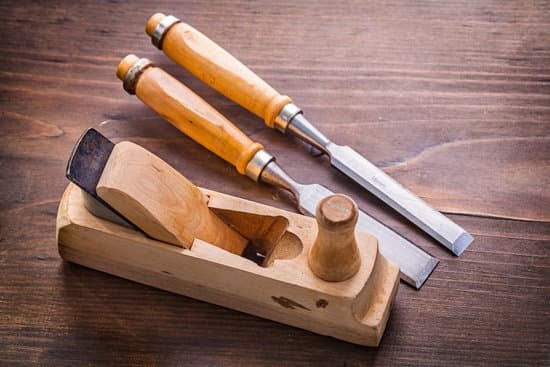Woodworking is a craft that requires precision, skill, and the right tools. Among these tools, chisels stand out as essential instruments for any woodworker. Chisels offer versatility and control, allowing craftsmen to shape and carve wood with utmost precision. In this article, we will explore the importance of chisels in woodworking projects and delve into the different types of chisels available.
Chisels play a vital role in woodworking as they allow artisans to remove excess material, create intricate designs, and achieve smooth finishes. Whether it’s roughing out joints or fine-tuning details, chisels are indispensable tools that every woodworker should have in their arsenal.
There are various types of chisels designed for specific purposes in woodworking. From bench chisels to mortise chisels, gouges to fishtail chisels, each type has its unique characteristics and uses. Understanding these different types of chisels will enable woodworkers to choose the appropriate tool for the task at hand and achieve optimal results.
So whether you’re a beginner or an experienced woodworker looking to enhance your skills, learning how to effectively use chisels is crucial. Now that we’ve established the importance of chisels in woodworking projects and introduced the different types available, let’s move on to the next section where we’ll discuss safety precautions and proper gear when using these versatile tools.
Safety First
When it comes to using chisels for woodworking, safety should always be the top priority. Chisels can be sharp and powerful tools that require caution and the right safety gear to prevent accidents. Before starting any woodworking project with chisels, it is important to familiarize yourself with the following precautions and proper gear:
Essential Safety Gear
- Safety Goggles: These should be worn at all times to protect your eyes from flying wood chips or debris.
- Ear Protection: When using chisels, especially with power tools, it can generate loud noises that may damage your hearing. Always wear ear protection such as earplugs or earmuffs.
- Respirator or Dust Mask: Woodworking often produces fine dust particles that can be harmful if inhaled. Use a respirator or dust mask to protect your lungs from sawdust and airborne contaminants.
- Protective Clothing: Wear long sleeves, pants, and closed-toe shoes to protect your skin from any potential injury.
- Work Gloves: While some woodworkers choose not to wear gloves when using chisels for better control and grip, others prefer wearing cut-resistant gloves for added protection.
Proper Handling Techniques
- Gripping the Chisel: Hold the handle firmly but avoid gripping too tightly as this can reduce control over the chisel.
- Pointers Away: Keep your fingers away from the path of the cutting edge of the chisel when working. This helps minimize the risk of accidental cuts.
- Secure Your Workspace: Make sure your work surface is stable, properly secured, and free from clutter. This reduces the chances of slips, falls, or injuries caused by tripping over objects.
Precautions
- Be Mindful of Grain Direction: When working with wood, it is important to chisel along the grain direction. Chiseling against the grain can result in tear-out or splintering.
- Avoid Excessive Force: Let the sharpness of the chisel do the work. Applying excessive force can lead to loss of control and increase the risk of accidents.
- Keep Blades Sharp: A dull chisel requires more force to cut through wood, increasing the chances of slips or mishaps. Regularly sharpen your chisels to maintain a sharp cutting edge.
By following these precautions and wearing proper safety gear, you can minimize the risk of accidents and injuries while using chisels for woodworking projects. Remember, safety is paramount in woodworking, ensuring both a successful project outcome and protecting yourself from harm.
Selecting the Right Chisel for the Job
When it comes to woodworking, selecting the right chisel for the job is crucial for achieving precise and clean cuts. With a wide variety of chisels available, it can be overwhelming to determine which one is best for your particular project. In this section, we will explore the different types of chisels and provide guidance on how to match the appropriate chisel to your woodworking project.
Understanding the different types of chisels available is essential in selecting the right tool. Some common types of chisels include bench chisels, mortise chisels, paring chisels, and dovetail chisels. Bench chisels are versatile and can handle a wide range of tasks, while mortise chisels are specifically designed for cutting square holes. Paring chisels have long and thin blades that are perfect for delicate work, while dovetail chisels are specialized tools used for creating dovetail joints.
When choosing the right chisel for your woodworking project, there are several factors to consider. The first factor is the type of wood you will be working with. Softer woods may require different types of blades compared to harder woods. Additionally, consider the size and scale of your project. For larger-scale projects, a wider blade may be more efficient, whereas smaller-scale projects may require a narrower blade for intricate details.
It’s important to note that investing in high-quality chisels will not only ensure better performance but also increase longevity. A well-made and properly maintained tool can last a lifetime. Before making your final decision on which chisel to use, take some time to research reputable brands and read reviews from other woodworkers. Ultimately, selecting the right chisel will greatly enhance your woodworking experience and yield superior results.
Preparing the Chisel for Use
Care and Maintenance Tips for Chisels
Before using a chisel for any woodworking project, it is important to ensure that it is in good condition. Taking care of your chisels will not only extend their lifespan but also guarantee optimal performance. Here are some care and maintenance tips to keep your chisels in top shape:
- Cleaning: After each use, remove any debris or wood shavings from the chisel blade using a soft cloth or brush. Avoid using harsh chemicals or solvents that could damage the steel or handle.
- Rust Prevention: To prevent rusting, especially if you live in a humid climate, it is advisable to apply a thin layer of oil or rust preventive wax on the blade when storing your chisels. This will create a barrier between the metal and moisture.
- Sharpening: Regular sharpening ensures that the chisel’s edge remains sharp and efficient. Use sharpening stones or diamond plates with different grits to achieve the desired level of sharpness.
Sharpening Techniques for Keeping the Chisel’s Edge in Top Condition
Keeping the chisel’s edge sharp is crucial for achieving clean and precise cuts in woodworking projects. Here are some sharpening techniques to maintain the sharpness of your chisels:
- Flatten the Back: Before sharpening the bevel, make sure to flatten the back of the chisel first. Use a coarse-grit sharpening stone and rub it against the back of the chisel in figure-eight motions until flat.
- Establish Bevel Angle: Determine the appropriate bevel angle for your specific chisel and project requirements. Most bench chisels have a bevel angle between 25-30 degrees while mortise chisels require angles ranging from 30-35 degrees.
- Honing Guide: Utilize a honing guide to achieve consistent and accurate bevel angles. The honing guide clamps the chisel securely and guides the sharpening stone or diamond plate along the edge.
- Sharpen Gradually: Start with a coarse-grit stone or plate to remove any nicks or damage on the edge, then gradually move to finer grits for a polished finish. Ensure you maintain even pressure while sharpening and maintain the bevel angle throughout.
How to Properly Handle and Store Chisels for Maximum Longevity
Proper handling and storage of your chisels are essential to prevent damage and accidents. Here are some guidelines on how to handle and store your chisels for maximum longevity:
- Use a Mallet: When striking a chisel, always use a wooden or rubber mallet instead of a metal hammer. This will help protect both the chisel and the workpiece from damage.
- Avoid High-Impact Tasks: Chisels should not be used for tasks such as prying, as this can cause irreparable damage to the blade.
- Store Properly: Store your chisels in a dry place where they won’t be exposed to moisture or extreme temperature fluctuations. Consider using tool rolls or cases specifically designed for storing and protecting chisels.
By following these care, maintenance, sharpening techniques, and proper handling practices, you can ensure that your chisels remain in optimal condition for years to come, allowing you to achieve precise and professional results in your woodworking projects.
Mastering Chisel Techniques
When it comes to woodworking, having a solid foundation of basic chisel skills is essential. This section will cover the fundamental techniques that every woodworker should master in order to create clean and precise cuts with their chisels. Proper hand positioning and grip are crucial for optimal chiseling, as they provide control and accuracy.
To begin, it is important to position your hand correctly on the chisel handle. The handle should rest in the palm of your hand, with your fingers wrapped around it for support. This grip allows for stability and control while applying pressure to the chisel. It is also advisable to use your other hand to guide and steady the chisel during use.
Another crucial aspect of basic chisel skills is understanding how to create clean and precise cuts. To achieve this, it is important to start by making shallow cuts before gradually increasing depth. This allows for better control and prevents unnecessary damage or splintering of the wood. Additionally, maintaining a consistent angle while cutting ensures uniformity throughout the project.
Lastly, controlling and maneuvering the chisel effectively can greatly enhance your woodworking experience. One technique for this is pairing downward pressure with a slight twisting motion as you advance along your cut. This helps prevent the blade from getting stuck or binding in the wood. It also allows you to follow curved or rounded features more smoothly.
By mastering these basic skills, you will have a strong foundation for using chisels effectively in your woodworking projects. With practice and patience, these techniques will become second nature, providing you with greater precision and control over your craftsmanship.
| Basic Chisel Skills | Skills Description |
|---|---|
| Proper Hand Positioning | Resting the handle in palm with fingers wrapped around for support |
| Clean and Precise Cuts | Starting with shallow cuts and gradually increasing depth, maintaining consistent angle |
| Controlling and Maneuvering the Chisel | Applying downward pressure with a slight twisting motion, following curved or rounded features smoothly |
Advanced Techniques
Once you have mastered the basic techniques of chiseling, you can explore a whole new world of possibilities with advanced chisel techniques. These techniques allow you to create intricate designs and patterns, add curved and rounded features to your woodworking projects, as well as utilize chisels for carving and sculpting wood.
One advanced technique that you can experiment with is creating intricate designs and patterns with chisels. By carefully controlling the depth and angle of your cuts, you can achieve beautiful ornamental details on your wooden surfaces. This technique requires precision and patience, as even the smallest error can ruin the design. It is advisable to start practicing on scrap or less visible areas before attempting it on your final project.
If you want to add curved and rounded features to your woodworking projects, a chisel can be a valuable tool. You can shape various wooden components such as table legs or chair arms by removing material gradually with a chisel. This technique requires careful planning and measurement in order to achieve symmetry and balance in your design. Take your time, make light cuts, and always check your progress along the way.
Lastly, chisels are not only useful for removing material but also for adding texture and dimension through carving and sculpting wood. This advanced technique allows you to bring life to your woodworking creations by adding intricate details or even creating sculptures using only a chisel. It requires creativity, skillful control of the tool, and plenty of practice. Start with simpler designs before moving on to more complex projects.
By exploring these advanced techniques, you can take your woodworking skills to new heights. Remember that practice makes perfect, so don’t be discouraged if it takes time to master these techniques. The key is to enjoy the process of learning and refining your craft with chisels.
| Advanced Technique | Description |
|---|---|
| Intricate Designs and Patterns | Create ornamental details through controlled cuts |
| Curved and Rounded Features | Shape wooden components with chisels for added dimension |
| Carving and Sculpting Wood | Add texture and create sculptures using chisels |
Troubleshooting Common Chisel Problems
Woodworking with chisels can sometimes pose certain challenges, but with the right knowledge and techniques, many common issues can be resolved. This section will address some of the most common problems that woodworkers encounter when using chisels and provide helpful tips for troubleshooting and solutions.
One common problem is dealing with chipped or damaged chisel edges. When a chisel’s edge becomes damaged or chips occur, it can greatly affect its performance and precision. To fix this issue, you’ll need to sharpen the damaged edge.
Start by reshaping the damaged area using a sharpening stone or honing guide to restore its original shape. Then move on to sharpening the entire edge to achieve a clean, sharp finish. Regular maintenance and proper sharpening techniques will help prevent further damage and extend the lifespan of your chisels.
Another problem that woodworkers may face is grain tear-out and splintering when working with certain types of wood. Tear-out occurs when fibers in the wood pull away as the chisel passes through it, resulting in a rough and uneven surface.
To minimize tear-out, pay attention to the direction of the wood grain and adjust your cutting technique accordingly. For example, if you find that your chisel is tearing towards the end grain, try taking lighter cuts or switch to a different type of chisel that is better suited for that particular task.
Lastly, it’s important to prevent issues such as chattering or skipping during use, which can affect both accuracy and safety. Chattering refers to an uncontrollable vibration or bouncing of the chisel while making cuts, while skipping happens when a smooth cut is interrupted abruptly due to improper handling or dullness of the tool. To avoid these problems, ensure a firm grip on the handle while keeping steady pressure and maintaining control throughout your workpiece.
Enhancing Results with Chisel Accessories
Chisel accessories can greatly enhance the results of your woodworking projects, allowing for more precise and efficient work. Whether you’re a beginner or an experienced woodworker, incorporating these accessories into your chisel toolkit can elevate your skills to the next level. In this section, we will explore some essential chisel accessories and how they can improve your woodworking experience.
Chisel Honing Guides
One of the most important aspects of using chisels is maintaining a sharp edge. A dull chisel not only makes cutting more difficult but also increases the risk of accidents. Chisel honing guides are valuable tools that help ensure consistent and accurate sharpening.
These guides hold the chisel at the correct angle while you sharpen it, making it easier to achieve a precise edge. They come in different styles and designs, with some even allowing for micro-bevel adjustments. By utilizing a chisel honing guide, you can achieve optimal sharpness every time without worrying about inconsistencies.
Sharpening Stones and Strops
Alongside a honing guide, sharpening stones and strops are indispensable accessories for keeping your chisels in top condition. Sharpening stones come in various grits and materials, such as waterstones or oil stones. The different grit levels allow for coarse grinding to remove nicks or create an initial bevel, as well as fine polishing to refine the edge.
Strops, on the other hand, are used for polishing and maintaining an already sharp edge. They usually consist of a leather strip treated with a compound that helps remove any burrs or imperfections left by the sharpening process.
Storage Solutions
Properly storing your chisels is crucial for their longevity and effectiveness. Chisels should be stored in a way that protects them from damage to both their blades and handles. There are several storage solutions available, ranging from simple sleeves or blade guards to customized chisel racks or cases. These storage options provide a safe and organized way to store your chisels, preventing accidental damage and making it easier to locate the one you need for a specific project.
Incorporating chisel accessories into your woodworking routine can significantly enhance your results. Chisel honing guides ensure consistent sharpening, sharpening stones and strops keep your edges at their best, and proper storage solutions protect your tools from damage. By utilizing these accessories, you’ll be able to work more efficiently and achieve cleaner cuts in your woodworking projects.
Conclusion
In conclusion, mastering chisel skills is crucial for any woodworking enthusiast or professional. Throughout this article, we have explored the importance of chisels in woodworking projects and the different types of chisels available. We have also emphasized the significance of safety precautions and proper gear when working with chisels.
Selecting the right chisel for the job is essential to achieve optimal results. Understanding the different types of chisels and considering factors such as thickness, width, and handle design can help ensure that you choose the appropriate tool for your woodworking project. Additionally, we have provided tips on how to prepare your chisel for use through care and maintenance techniques and proper sharpening methods.
Mastering basic chisel skills is a necessary foundation for any woodworker. By practicing proper hand positioning, grip, and learning techniques for creating clean cuts, you will be able to manipulate your chisel effectively and achieve precise results. Furthermore, we have delved into advanced techniques such as creating intricate designs and patterns, carving curved features, and sculpting wood with chisels.
While troubleshooting common problems with chisels may arise, it is important to identify and address these issues promptly. By recognizing problems such as damaged edges or grain tear-out, you can employ strategies to fix them and prevent similar issues in the future. Additionally, we have highlighted accessories that can enhance your results, such as honing guides and sharpening stones.
Frequently Asked Questions
What is the correct way to use a wood chisel?
The correct way to use a wood chisel is to first ensure that the tool is sharp and in good condition. This can be done by using a sharpening stone or honing guide to maintain a sharp edge. When gripping the chisel, it is important to hold it firmly but not too tightly to allow for proper control and movement. When making cuts, start by positioning the chisel at an angle on the workpiece with the beveled side facing downward.
Use controlled downward pressure while pushing or tapping the top of the chisel handle to make shallow or deeper cuts respectively. It is crucial to always work away from your body and use a mallet instead of directly striking the handle. Additionally, ensure that you are wearing safety goggles and protective gloves when using a wood chisel.
How do you use a chisel for beginners?
For beginners, it is important to start by choosing the right kind of wood chisel suited for your project. A basic bench chisel with a 1/2-inch width is often recommended as a versatile option for beginners due to its ability to handle various tasks effectively. Before using the chisel, it’s essential to familiarize yourself with its parts – such as the blade, bevel, tang, handle, and shoulder – so that you know how each component functions during carving or cutting.
Practice controlling the tool’s movement by making light shallow cuts on scrap wood before moving on to more complex projects. Focus on maintaining steady hand movements and take breaks if necessary to avoid fatigue or loss of concentration.
How do you carve wood with a chisel?
When carving wood with a chisel, it’s crucial to have a clear plan and visual representation of what you want to create before starting any cuts. Begin by securing your workpiece in place with clamps or a vise so that it remains stable throughout the carving process. Start with rough shaping or removing large portions of material by making horizontal slicing cuts across the grain using your chisel’s bevel edge. Gradually work towards finer details, making sure to constantly check and refine the shape as you progress.
To carve intricate designs or create texture, use short, controlled strokes with a small chisel or gouge. It’s important to keep your chisel sharp at all times during carving to ensure clean and precise cuts, and to avoid forcing the tool through the wood which may lead to damages or accidents. Regularly evaluate your progress and make adjustments as needed until you achieve the desired carved wood result.

Hi everyone! I’m a woodworker and blogger, and this is my woodworking blog. In my blog, I share tips and tricks for woodworkers of all skill levels, as well as project ideas that you can try yourself.





